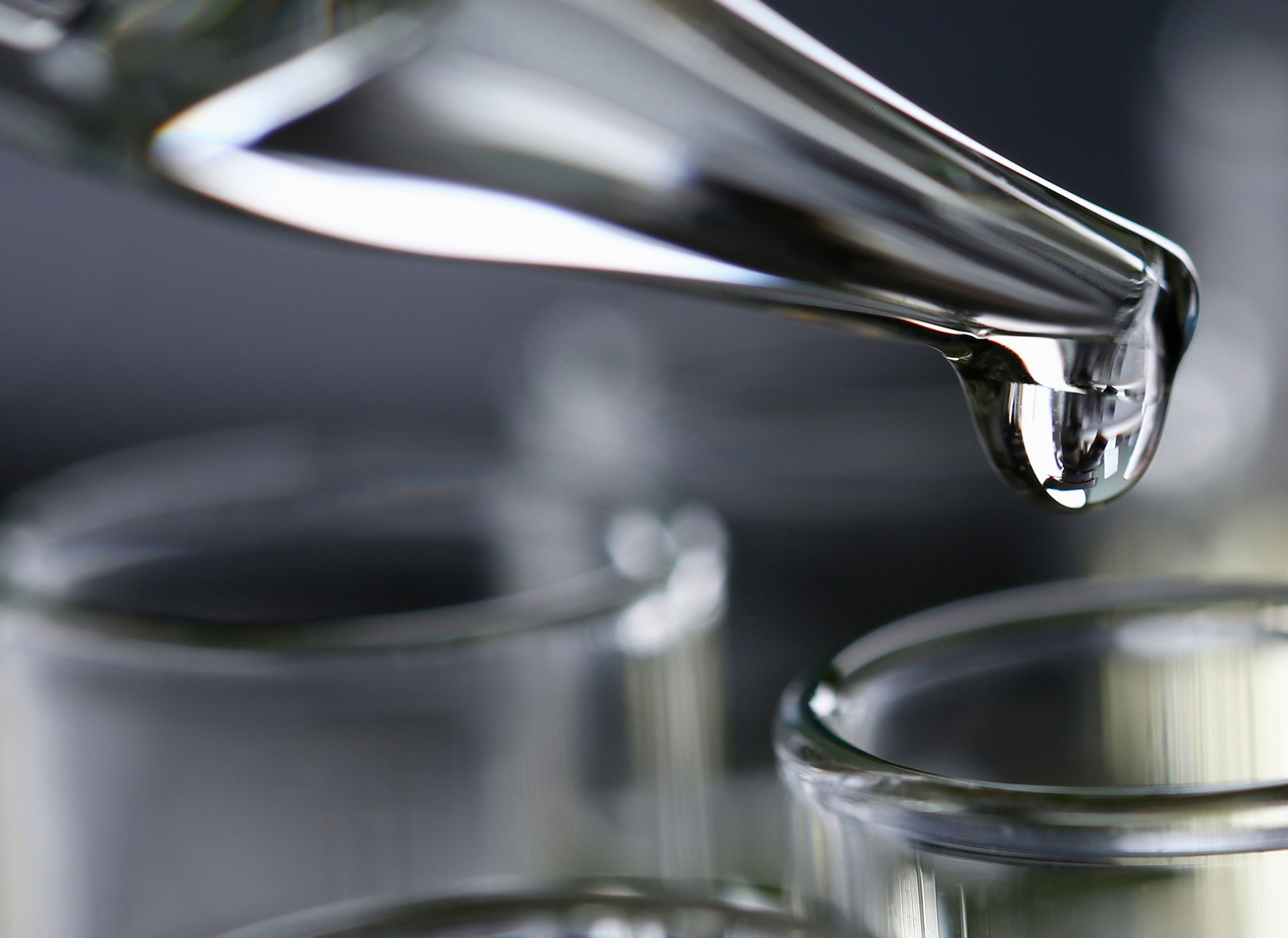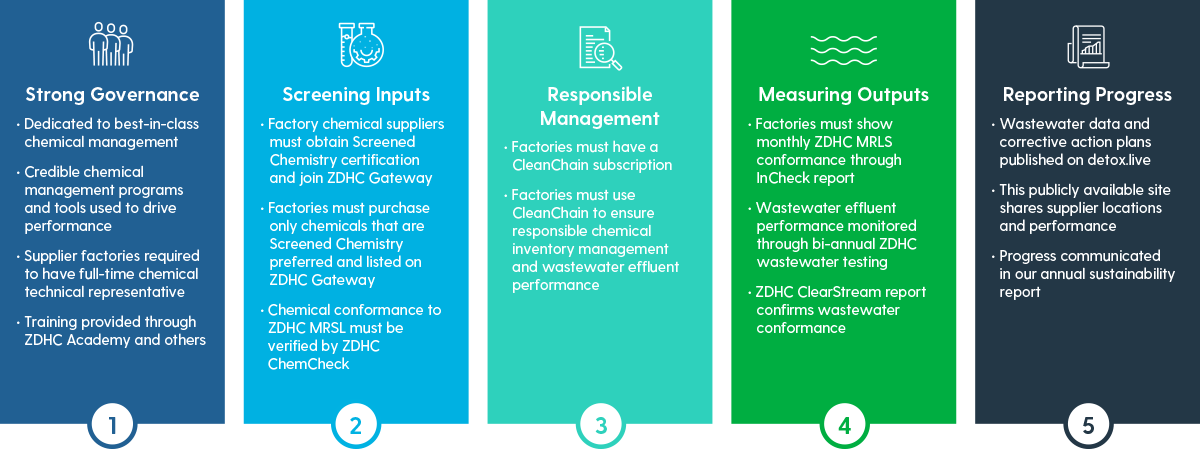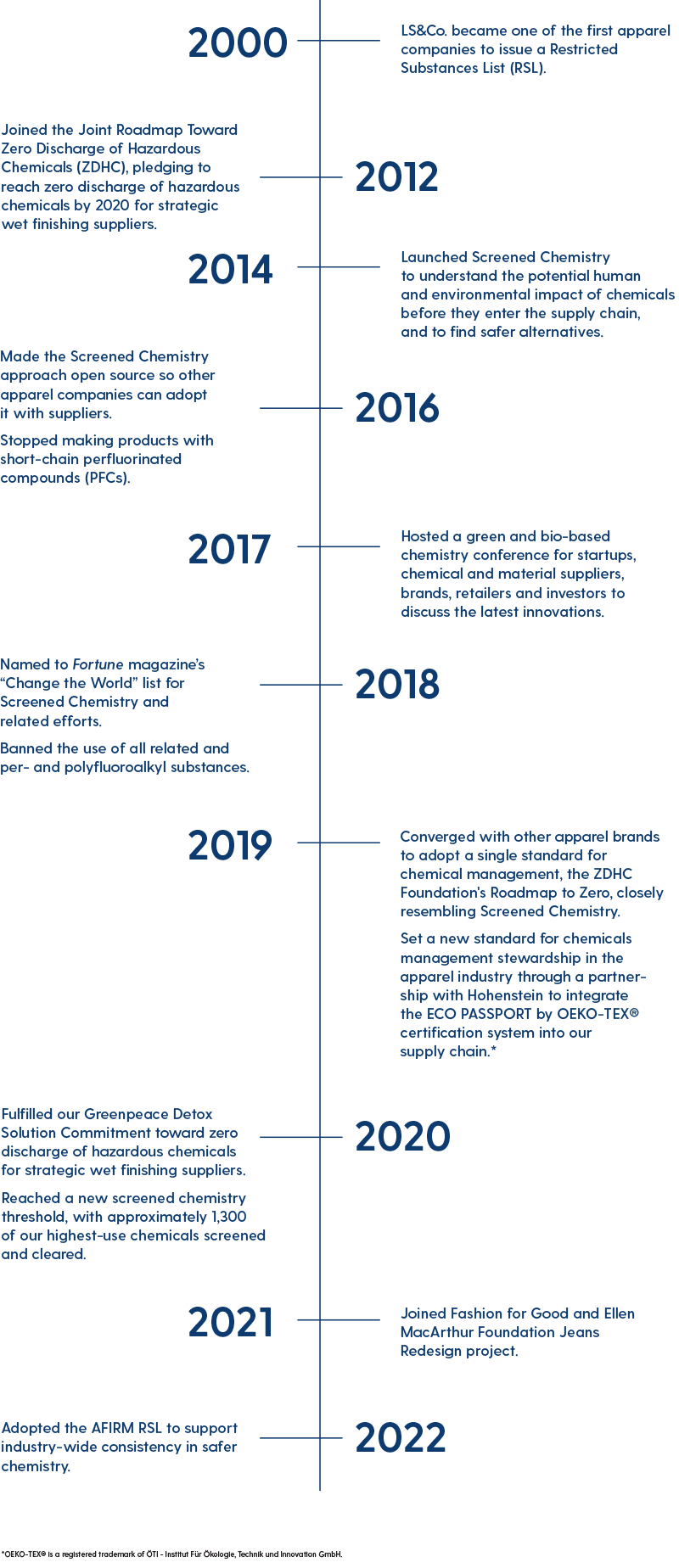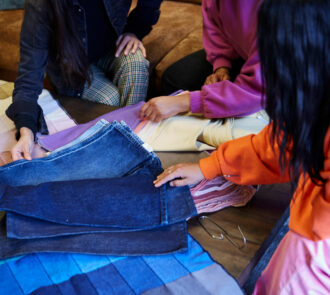Safer Chemicals, Safer Products
As of January 1, 2016, LS&Co. stopped producing products with any perfluorinated chemicals (PFCs) — that have unique properties to make materials waterproof and stain resistant. We extended our use ban to cover all per-and polyfluoroalkyl substances (PFAS) in 2018. Our ban on PFCs and per- and PFAS is significant, considering there are currently no equally effective water- and stain-repelling alternatives.
The LS&Co. RSL prohibits the use of priority chemicals identified by Greenpeace and ZDHC, including alkyl phenol ethoxylates, phthalates, short- and medium-chained chlorinated paraffins, flame retardants and others. We take measures to fully enforce our ban on alkyl phenol ethoxylates (APEOs) — chemicals used in some detergents and surfactants. Suppliers are not allowed to intentionally use these banned chemicals in LS&Co. products.
In addition to ensuring suppliers adhere to Screened Chemistry, monitoring supplier wastewater quality and encouraging them to use chemicals from our preferred list, we also conduct testing on finished garments. This includes product testing for chemicals as well as mechanical and construction characteristics, such as flammability and various product safety requirements for children’s wear.
During 2021, we achieved a product testing pass rate of 99.94% in both development and production testing against our RSL. Additionally, periodic and random product testing at 80% of Tier 1 factories demonstrated a 100% pass rate, indicating that our products consistently meet our strict requirements globally. In 2022, we hope to extend our random testing to footwear and accessories as well. Globally, LS&Co. is consistent in demonstrating the utmost product safety compliance with regulatory requirements. Several of the countries in which we operate, including the U.S., have either a national product liability reporting system or participate in a regional reporting system that provides publicly available data. No LS&Co. products were reported as recalled in any of those national or regional reporting systems in 2021.
Restricted Substances Stewardship Program
We launched the Restricted Substances Stewardship Program (RSSP) in 2014 to ensure conformance with the ZDHC Roadmap and the successful elimination of priority chemicals as identified by Greenpeace and ZDHC. The program provides guidance and a plan to eliminate priority chemical use and discharge, while supporting safe and responsible chemicals management.
Through the RSSP, we require manufacturing suppliers to prioritize responsible chemicals management. They are required to work closely with chemical suppliers and analytical laboratories to ensure that responsible management extends throughout the supply chain. This provides us with transparency into program implementation and promotes accountability. LS&Co. monitors RSSP performance and compliance status monthly. We have focused on implementing the program with suppliers and aligning the RSSP with the ZDHC MRSL, as well as on other tools and training developed within the ZDHC Roadmap.
From Chemical Risk to Chemical Hazard
Although the words are sometimes used synonymously, hazard refers to a substance’s inherent properties that make it capable of causing harm to human health or the environment. Risk, on the other hand, is the possibility or likelihood of a harmful event coming from exposure to a substance. That’s why we see preventing hazards as the right approach to chemical management.
As part of our continued evolution in sourcing the safest possible chemicals in our supply chain, the Screened Chemistry system was designed to shift us and our suppliers from a risk-based to a hazard-based chemical management approach. Since 2014, we have been evaluating chemical formulations from a hazard lens with the help of third-party toxicology experts. This includes looking at the full material disclosure of chemical compounds in a given substance to make the right selection. Screened Chemistry allows us to validate all incoming chemicals through hazard assessment to ensure they contain no chemicals of concern, regardless of percentage within the formulation. This is in contrast to a risk-based approach, which does not require full disclosure and can only reduce the likelihood of negative outcomes and unsafe outputs at the end of the pipeline.
Our RSL and the ZDHC MRSL indicate chemicals that are banned or limited to a certain threshold in our products and in our manufacturing processes, respectively. However, for the effective elimination of harmful chemicals beyond what is currently restricted and regulated, Screened Chemistry — with full chemical formulation disclosure — allows us to identify chemicals of concern in advance of regulations.
Screened Chemistry
The pioneering Screened Chemistry approach examines chemicals used to manufacture our products against specific health and environmental impacts, allowing us to identify better alternatives and areas for innovation. The aim is for all LS&Co. suppliers to use our Preferred Chemical List, which represents safer alternatives for manufacturing. This is a much more proactive approach to sustainable chemicals management in the industry, and one that we open sourced to benefit the entire supply chain.
To date, we have screened and cleared approximately 1,300 of our highest-use chemicals. Screening was performed by a toxicologist, validating RSL and ZDHC MRSL compliance as well as ensuring full material disclosure of the chemical formulation. We have shared the Screened Chemistry program with others in the industry and with the ZDHC Foundation, which is working on adopting the program as part of the ZDHC Aspirational Chemical Management level.
Importantly, the Screened Chemistry approach exceeds legal requirements for chemical safety. Under Screened Chemistry, any impurity or addition to a chemical must be disclosed and meet the ZDHC MRSL. To this end, Screened Chemistry has also included a pilot on commodity chemicals — the bulk chemicals that serve as building blocks in chemical processes and are the largest volume of chemicals used in apparel supply chains. Including commodity chemicals in the Screened Chemistry approach is a breakthrough for our supply chain. The commodity chemicals used in the apparel industry sometimes come from other industries, such as pharmaceuticals, and can contain impurities, residuals or contaminants from those other industrial uses. Commodities are difficult to address, but we are up for the challenge. We know that meeting our safer chemical ambitions requires us and the industry to address these chemicals.
On the Way to 100% Screened Chemistry at Strategic Facilities
Our goal is to implement certified Screened Chemistry at 100% of strategic garment wet finishing manufacturing and fabric mills as part of upholding our ZDHC commitment. Impurities screened by the program are measured down to 100 parts per million.* Our Preferred Chemical List, along with the corresponding hazard scores, are available through the ZDHC Gateway. This gives suppliers the resources they need to select safer chemicals.
We also continue focusing efforts on Tier 2 suppliers, including encouraging our Tier 1 suppliers to engage more of their vendors that have adopted the Screened Chemistry program.
*Strategic garment wet finishing manufacturing and fabric mills cover approximately 80% of product weight.
CleanChain Tool
Third-party toxicologists upload Screened Chemistry certificates to the CleanChain tool, where they can be accessed by our key suppliers. As of the close of 2021, more than 100 facilities, including factories, mills and laundries are uploading their chemical purchases and deliveries. This allows us to see the chemicals used, by weight or volume, in those factories on a monthly basis. This tool allows us to have an outsized impact on safer chemical management beyond our own products, as our shared suppliers apply many of these preferred chemicals to the garments they produce for other, non-LS&Co. brands.
We actively monitor chemical usage and wastewater impacts at Tier 1 and 2 facilities through both the CleanChain tool and ZDHC Gateway web application. Supplier chemical use is also cross-checked through bi-annual wastewater testing. The monthly chemical use report is publicly available on the ZDHC Gateway and the wastewater data is available on the ZDHC detox.live platform. The latter provides year-over-year wastewater quality data. Finally, any factory demonstrating an issue with wastewater quality is subject to a corrective action plan, which also must be uploaded to the ZDHC detox.live site.
Monitoring Our Supply Chain
We monitor for substances of concern by tracking our suppliers’ testing of chemicals and through wastewater testing. We maintain specific performance standards by product category and conduct RSL testing based on hazards at both development and manufacturing stages against applicable standards in our Product Integrity Portal.
By closely monitoring chemical safety standards and usage across the supply chain, we are better able to identify and eliminate potential RSL non-compliances at early stages of product development, preventing further wastewater contamination. Both Tier 1 and Tier 2 factories are encouraged to participate in the ZDHC Supplier to Zero program, through which suppliers can connect to the ZDHC Gateway database and implement ZDHC’s sustainable chemical management system.
Substances of Concern Declarations
Since its inception, our approach to safer chemicals has been designed to make sure that no intentional use of substances of concern occurs in the manufacturing of our products. Today, our priority chemicals list as well as our usage ban for PFAS, antimicrobials, flame retardants and other substances of concern are clearly documented in the LS&Co. Product Safety by Design Framework for RSL. We also regularly provide product declarations to various customer inquiries. This includes adhering to REACH requirements for responding in a timely fashion to external inquiries about use of any substances of very high concern. To continue ensuring product safety, we regularly review and update our RSL document, while also seeking to add chemicals to our Preferred Chemical List and phase out emerging chemicals of concern.
Progress Toward Scalable Plant-Based Indigo
Over the years, LS&Co. has tested a variety of botanical dyes, but we have generally found they produce variations in color that customers don’t like, in part because there is no non-chemical color fixing agent available to lock in a desired level of color saturation. We believe plant-based indigo dye shows promise for widespread use.
As part of our work with Fashion for Good, in 2021 we forged a collaboration with Stony Creek Colors to pilot the use of plant-based, pre-reduced indigo at scale, part of our ongoing efforts to reduce the number of potentially harmful chemicals in the denim supply chain. This is a new program for us with the Fashion for Good partnership, but it continues an existing collaboration with Stony Creek Colors. The Levi’s® brand has worked with Stony Creek Colors’ plant-based dyes for several seasons of its WellThread® collections, infusing their plant-based indigos into the line’s various denim pieces.
The program is running performance trials on IndiGold™ indigo dye at selected denim mills using different dyeing systems.* The goal is to unlock learnings around shade application and other efficiencies. The project aims to have additional garments dyed with IndiGold™ on the market by late 2022 and early 2023. As an added benefit, Stony Creek Colors grows its indigo on former tobacco farms providing income to farmers shifting their operations to different crops.
*IndiGold™ is a trademark of Stony Creek Colors.
Partnerships and Certifications for Progress
We believe in industry collaboration to bring scale and scope to our commitment to zero discharge of hazardous chemicals. Over the past two years, we announced key partnerships to strengthen the program:
- We have two key partnerships to advance sustainable chemicals management with Scivera and NimkarTek Laboratory to pioneer cutting-edge approaches for screening and tracking bulk commodity chemicals in apparel supply chains.
- We partnered with the Hohenstein Institute to use the ECO PASSPORT by OEKO-TEX® certification system for enhanced testing, verification and transparency to chemical suppliers.
- We encouraged Scivera and Jeanologia to develop an Environmental Impact Measurement (EIM) tool for chemicals certification, and the resulting system is being piloted. We are exploring the possibility of implementing EIM for chemicals, in addition to the energy and water EIM, which we already use.
In addition, our LS&Co. Product Safety by Design Framework for RSL document highlights LS&Co.’s preferred fiber and apparel certification schemes, including the Global Organic Textile Standard (GOTS), Global Recycled Standard (GRS), and several OEKO-TEX® standards — ECO PASSPORT, STANDARD 100, MADE IN GREEN, LEATHER STANDARD and STEP.
What’s Next – Safer Chemicals
We remain as committed as ever to advancing the use of safer chemicals. Above and beyond our 2026 commitment that strategic garment wet finishing manufacturing and fabric mills use 100% certified Screened Chemistry, we will continue to advance strategies, programs and collaborative efforts with key partners to develop and scale sustainable chemicals management strategies across the apparel sector.*
This includes continuing to partner with ZDHC, AFIRM, Fashion for Good and others to create more sustainable change at scale, eliminate hazardous chemical use and improve wastewater treatment practices across the industry. In 2022, we plan to conduct an OEKO-TEX® pilot for chemical commodities at selected factories in support of future OEKO-TEX® STANDARD 100 product certification. We will also continue our collaboration with the Hohenstein Institute to use the ECO PASSPORT by OEKO-TEX® certification system to better implement our chemicals management processes and create a template for the apparel industry.**
*Strategic garment wet finishing manufacturing and fabric mills cover approximately 80% of product weight.
**OEKO-TEX® is a registered trademark of ÖTI – Institut Für Ökologie, Technik und Innovation GmbH.












